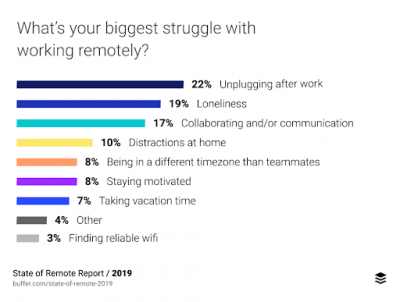Employee engagement was an issue long before our world and work were disrupted entirely. Is it likely to improve on its own as teams widely transition into unfamiliar distributed settings?
According to data trends and intuitive logic… not remotely.
Consider that in 2017, Gallup conducted a study and found that 85% of workers were “not engaged or actively disengaged.” Around that time, about 43% of people reported worked remotely in some capacity. Fast-forward to mid-March of this year, where new data showed that 58% of Americans were working remotely. This figure has likely ticked up in the weeks since, with shelter-in-place measures growing more prominent and stringent.
Unfortunately, the impact of disengagement by distance is plain to see.
Why Remote Employee Engagement Is an Issue
At its root, employee engagement is about culture, and understandably, companies are still figuring out how to develop inclusive and cohesive cultures for distributed teams. There are numerous ways remote disengagement can manifest, from low productivity to interpersonal animosity.
A few years back, VitalSmarts surveyed 1,100 professionals and concluded that remote workers felt shunned and left out. Results showed that the remote cohort was more likely to feel unrepresented, and ganged up against by colleagues.
What’s Driving the Disconnect?
For its State of Remote Work 2019 report, Buffer asked remote workers about the biggest struggles they face in this setting. The top three answers: Unplugging after work (22%), Loneliness (19%), Collaborating and/or communication (17%).

Again: intuitively logical on all counts. There are no easy answers to these inherent drawbacks of distributed teamwork, but technology is increasingly bringing us new ways to knock down the barriers.
Extensible chat applications and video conferencing software are fixtures, now more than ever. But they are only pieces of the puzzle. The next step in addressing the foremost challenges cited above – work/life balance, loneliness, collaboration – lies in finding ways to replicate the physical office environment with a team spread out across vast geographical distances.
Virtual office platforms like the one we offer at Ignite seek to close the gap. The basic idea is to recreate the sort of spontaneous encounters, casual standups, and group spitballing sessions that lead to collective breakthroughs. Workers feel present, teammates are connected, and managers have visibility.
There are numerous solutions out there addressing the dilemma of remote disengagement, and they’ll only continue to grow more robust and extensive. That’s the good news. But there’s better news.
A Bright Future for Those Ready to Seize it
Yes, it is certainly fair to say remote workers feel more disconnected and disengaged than their in-office counterparts, but here’s the flipside: they’re also happier and more satisfied with their jobs.
The 2019 State of Remote Work survey from OwlLabs found that “remote workers say they’re happy in their jobs 29% more than on-site workers.” Buffer’s study showed that 95% of remote workers would encourage others to do so, while 99% indicated they’d like to continue working remotely in their careers.
Employees want to have this option, especially once they’ve experienced it. That’s clear. They enjoy the schedule flexibility, the ability to work from anywhere, and the extra time with family. So when companies are able to overcome the remote disengagement hurdle, they’re primed to unlock maximum productivity, job satisfaction, and loyalty from their teams. Those organizations that look the other way risk placing themselves at a grave disadvantage in these areas.
“Work flexibility is becoming the norm,” said Jason Phillips, VP Digital HR & Global Chief of Staff for Cisco, in LinkedIn’s 2019 Global Talent Trends Report. “The challenge is how fast can organizations provide it. Those that can are going to be in a far better position to retain top talent over the next three to five years.”
Last year’s timeline has been accelerated irreversibly. Employee engagement is a longstanding issue with a new set of variables and ramifications. While there are many different ways to go about solving this challenge in the unfolding remote work era, the worst mistake any business leader can make is overlooking it.
See first-hand how a virtual office platform can bring your remote team together and help your company overcome disengagement by distance. Check out Ignite Sococo.






